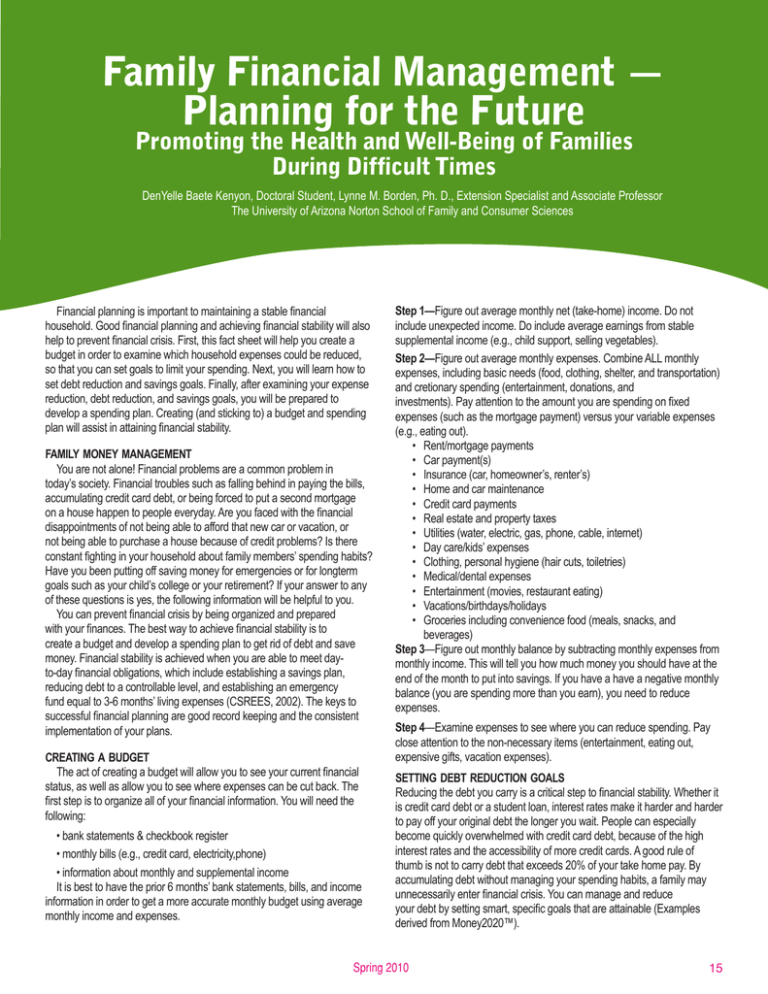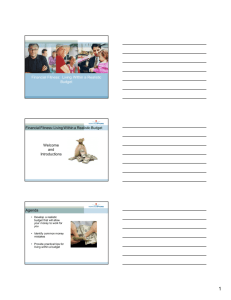Family Financial Management — Planning for the Future During Difficult Times
advertisement

Family Financial Management — Planning for the Future Promoting the Health and Well-Being of Families During Difficult Times DenYelle Baete Kenyon, Doctoral Student, Lynne M. Borden, Ph. D., Extension Specialist and Associate Professor The University of Arizona Norton School of Family and Consumer Sciences Financial planning is important to maintaining a stable financial household. Good financial planning and achieving financial stability will also help to prevent financial crisis. First, this fact sheet will help you create a budget in order to examine which household expenses could be reduced, so that you can set goals to limit your spending. Next, you will learn how to set debt reduction and savings goals. Finally, after examining your expense reduction, debt reduction, and savings goals, you will be prepared to develop a spending plan. Creating (and sticking to) a budget and spending plan will assist in attaining financial stability. family money management You are not alone! Financial problems are a common problem in today’s society. Financial troubles such as falling behind in paying the bills, accumulating credit card debt, or being forced to put a second mortgage on a house happen to people everyday. Are you faced with the financial disappointments of not being able to afford that new car or vacation, or not being able to purchase a house because of credit problems? Is there constant fighting in your household about family members’ spending habits? Have you been putting off saving money for emergencies or for longterm goals such as your child’s college or your retirement? If your answer to any of these questions is yes, the following information will be helpful to you. You can prevent financial crisis by being organized and prepared with your finances. The best way to achieve financial stability is to create a budget and develop a spending plan to get rid of debt and save money. Financial stability is achieved when you are able to meet dayto-day financial obligations, which include establishing a savings plan, reducing debt to a controllable level, and establishing an emergency fund equal to 3-6 months’ living expenses (CSREES, 2002). The keys to successful financial planning are good record keeping and the consistent implementation of your plans. creating a budget The act of creating a budget will allow you to see your current financial status, as well as allow you to see where expenses can be cut back. The first step is to organize all of your financial information. You will need the following: • bank statements & checkbook register • monthly bills (e.g., credit card, electricity,phone) • information about monthly and supplemental income It is best to have the prior 6 months’ bank statements, bills, and income information in order to get a more accurate monthly budget using average monthly income and expenses. Step 1—Figure out average monthly net (take-home) income. Do not include unexpected income. Do include average earnings from stable supplemental income (e.g., child support, selling vegetables). Step 2—Figure out average monthly expenses. Combine ALL monthly expenses, including basic needs (food, clothing, shelter, and transportation) and cretionary spending (entertainment, donations, and investments). Pay attention to the amount you are spending on fixed expenses (such as the mortgage payment) versus your variable expenses (e.g., eating out). • Rent/mortgage payments • Car payment(s) • Insurance (car, homeowner’s, renter’s) • Home and car maintenance • Credit card payments • Real estate and property taxes • Utilities (water, electric, gas, phone, cable, internet) • Day care/kids’ expenses • Clothing, personal hygiene (hair cuts, toiletries) • Medical/dental expenses • Entertainment (movies, restaurant eating) • Vacations/birthdays/holidays • Groceries including convenience food (meals, snacks, and beverages) Step 3—Figure out monthly balance by subtracting monthly expenses from monthly income. This will tell you how much money you should have at the end of the month to put into savings. If you have a have a negative monthly balance (you are spending more than you earn), you need to reduce expenses. Step 4—Examine expenses to see where you can reduce spending. Pay close attention to the non-necessary items (entertainment, eating out, expensive gifts, vacation expenses). setting debt reduction goals Reducing the debt you carry is a critical step to financial stability. Whether it is credit card debt or a student loan, interest rates make it harder and harder to pay off your original debt the longer you wait. People can especially become quickly overwhelmed with credit card debt, because of the high interest rates and the accessibility of more credit cards. A good rule of thumb is not to carry debt that exceeds 20% of your take home pay. By accumulating debt without managing your spending habits, a family may unnecessarily enter financial crisis. You can manage and reduce your debt by setting smart, specific goals that are attainable (Examples derived from Money2020™). Spring 2010 15 Method 1—Reduce total credit card debt by ___% Example: The Anderson family has a total of $3,050 in credit card debt. They are considering reducing that debt load by 20%, or $610 in one year. This will require an extra $12 per week set aside for debt repayment ($610 / 52 weeks = $11.73 per week or approximately $50 per month). setting savings goals Saving money is another positive step on the road to financial security. Even if you have large amounts of debt to pay off, you may want to start putting away $5 a week, just to get in the habit of saving. You may want to have a portion of your paycheck directly deposited into your savings account. That way, you will never miss the money or have access to it. Whether saving for a specific purchase (such as a vacation), or setting up a savings account, it is important not to dip into the savings pool for other reasons. This becomes a bad habit and defeats the purpose of having a savings goal. Remember to set specific goals that are attainable. To attain financial security, first focus on short term goals, such as setting up an emergency fund, or saving a percentage of income per year. Method 1—Establish an emergency fund of at least 2 months of salary to cover 3-6 months’ living expenses. This is a good first step for a savings plan if you do not currently have funds available for unexpected expenses like medical emergencies, replacements, and repairs (for cars, appliances, etc.). Example: The Lopez family will set aside $2,500 in their emergency fund within 18 months. They need to set aside $138.88 per month or approximately $33 per week to achieve this savings goal. Method 2—Save a certain percent of income per year. Most financial planners recommend saving at least 10% of annual income for long term future goals. Example: The Lopez family decides to save 10% of annual take home income which for them will be $2500 per year. This amounts to $207 per month or about $48 per week ($2500 / 52 weeks = $48). Developing a spending plan Step 1—Follow the procedures described above to create a budget. Track your spending for three months and carefully monitor your ATM withdrawals and incidental spending. Examine the budget’s monthly balance—ask yourself what unnecessary expenses you can cut out. Remember to provide for needs before wants. Step 2—Examine your expense reduction goals, debt reduction goals, and savings goals. The objective should be to match your family’s spending to your current income. Combine information about your family’s income and expenses from your previous budget and make adjustments according to expense goals, debt reduction goals, and savings goals. This becomes your new plan for spending and saving. Step 3—Develop a new spending plan from the budget and stick to it! The best way to follow your spending plan is to keep track of everything your family purchases in a notebook. If you set realistic spending and savings goals, you shouldn’t have a difficult time in following the plan, but if you find the budget constrictive, don’t be afraid to make small adjustments. This is better than dropping your spending plan altogether. 16 Dave x83's Method 2—Completely pay off credit card debt within ___ years. Example: To pay off $3,050 in the next three years, the Anderson family may divide the dollar amount owed by the number of months until the deadline. Three years will equal 36 payments until the deadline. They will need to pay $85 off the principal each month in addition to the interest on the unpaid balance in order to eliminate this debt by their deadline ($3050 /39 months = $84.72 + interest per month). internet resources Arizona Saves: Affiliated with the America Saves program, Arizona Saves helps people save money, build wealth, and get out of debt. http://www.arizonasaves.org/ Financial Calculators: Calculators that can help you figure out how to set your debt and savings goals. http://www.ace.uiuc.edu/cfe/calculators.html Take Charge America: Phoenix based organization that provides education, counseling, and debt management. http://tcainstitute.org/cwc.html National Endowment for Financial Education (NEFE): Information on ways to save money, tips on how to become a savvy saver, a savings quiz, and financial calculators to help figure out how long it would take to save money or pay off a loan. http://www.nefe.org/ Additional NEFE sites: High School Financial Planning Program® (HSFPP) http://hsfpp.nefe.org CashCourse: Web-based financial education for college students. www.CashCourse.org SmartAboutMoney: One-stop shop for consumers wwwSmartAboutMoney.org Spendster: Confess what you shouldn’t have bought. www.Spendster.org references Bristow, B.J. Money 2020. http://www.americasaves.org/ Cooperative State Research, Education, and Extension Service (2003). Measurement of money management desired outcomes. http://www.csrees. usda.gov/nea/economics/res/security_res_moneymtg3.html Hallman, G.V. & Rosenbloom, J.S. (1975). Personal financial planning: How to plan for your financial freedom. New York: McGraw-Hill, Inc. Article originally published at: http://cals.arizona.edu/pubs/family/az1341/az1341i.pdf & Backyards Beyond






